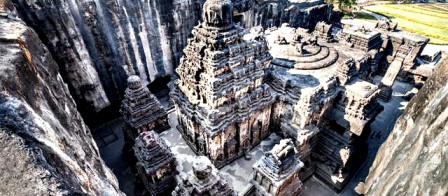The Kushan Empire – History Study Notes & Stuff
The Kushan had originally belonged to the regions of western China and they are also known as the ‘Yue-chi’. The Kushans defeated the Sakas and the Parthians/Pahlavas. Then went on to create a big empire in Afganistan, Pakistan and Northern parts of India.
The first important ruler of the Kushan dynasty was Kujula Kadphises or Kadphises He occupied the valley of Kabul and had also issued coins in his name. He was then succeeded by his son, Vima Kadphises or Kadphises II. He conquered the territories of northern India up to Mathura. He issued coins declaring himself a Shiva devotee and ruler of the whole world.
There after the Kushan empire was ruled by Kanishka and He is considered the most important ruler of the Kushan dynasty.
Kanishka’s Reign and Buddhism:
Kanishka usurped the throne in 78 AD, and then started a new era, what is known to us as the Shaka era. Under Kanishka's rule, the Kushan Empire reached its maximum territorial limits. The empire stretches from Central Asia to North India, while the Uttar Pradesh region includes Kaushambi, Varanasi and Shravasti.
The political significance of Kanishka's rule is largely due to his achievements as he integrated Central Asia with North India under a single empire. This allowed different cultures to be separated and also increased inter-regional trading activities.
Kanishka is famous in history as a great patron of Buddhism. He is credited with convening the fourth Buddhist Council at Kundalavan, located at present day Harwan near Srinagar in Jammu and kasmir. In this 4th Buddhist Council, a large number of Buddhist scholars took part. This council is important in the history of Buddhism for the developments. In this council Buddhism was divided into two distinct schools - Hinayana & Mahayana. Near 500 monks had attended the Council. This council had prepared an official commentary on Tripitaka and the Mahayana doctrine was finalized here.
Kanishka is also known to patronize the Gandhara and Mathura schools of sculptural art . He also built a huge stupa to keep the relics of the Buddha at his capital Purushapura, present in Peshawar. The building was intact in its grandeur when the Chinese pilgrim Fahian visited the area when he arrived in the early 5th century. The Kushan power was gradually reduced from the beginning of the 3rd century.
Kanishka had also sent missionaries to the Central Asia and China to propagate the new faith of Buddhism. Buddhist chaityas and viharas were built at various places. He also patronised the Buddhist scholars – Ashwaghosha, Vasumitra and Nagarjuna. Ashwaghosha was a great philosopher, poet and playwright of his time. He was also the author of Buddhacharita. While Nagarjuna came from south India, he adorned the court of Kanishka.
Kanishka also patronized the famous physician Charak of ancient India.
Kushan Polity and Administration:
The Kushanas empire was divided into provinces, each ruled by a military governor (mahakshatrapa), who was assisted by a kshatrapa, But not know how many provinces were there in the empire. Sources reveal that Kushan horsemen wore trousers while riding. A headless statue of Kanishka found at Mathura reflects the same. A prominent feature of Kushan politics was the title of Devaputra, meaning son of God, which was used by the Kushan kings and indicates the claim of divinity by the Kushan kings.
The Contributions of Kushans:
The Kushans have made a special place in ancient Indian history due to their contribution to various aspects of life.
His vast empire helped in the development of internal and external trade. It resulted in the rise of new urban centres. The prosperous state of the economy under the Kushans is also evident from the large number of gold and copper coins. Even in literature and medicine, India made progress. Charak is known as the father of Ayurveda. He wrote a book on medicine called Charaka Samhita, while Ashwaghosh, a Buddhist scholar, wrote the entire biography (Buddhacarita) of the Buddha. Both these scholars were believed to be the contemporaries of king Kanishka. The Kushans patronized the Gandhara and Mathura school of sculptural art which knows for producing early picture of the Buddha and the Bodhisattvas.
The successors of Kanishka and the end of Kushan rule:
The successors of Kanishka had ruled for another one hundred and fifty years. His son Huvishka kept the empire intact. He was also a patron of Buddhism, like his father Kanishka.
The last significant Kushan ruler was Vasudeva. Under his rule, the Kushan Empire was greatly reduced. Various inscription with his name are found in and around Mathura. He was a worshipper of Siva. After Vasudeva, petty Kushan rulers ruled for some time in Western India after which the empire broke away.
If you want us to add any more details to this article, please do let us know in the comments below.








0 Comments